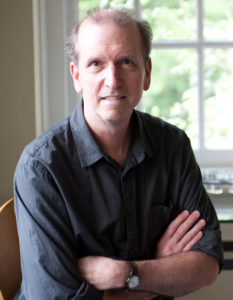
You’re probably no stranger to the work of author-illustrator David Wiesner, who has won the Caldecott Medal three times, for his picture book TUESDAY in 1992, THE THREE PIGS in 2002 and FLOTSAM in 2006.
But who’s the man behind all that amazing art and stories? We asked…
Booking Biz: What does your average day look like?
David: I’ve always worked from home. I’ve had 3 average days – before kids were born, after kids started school, and after kids reached driving age.
Before we had kids I was a night person – up at, say, eleven, work until my wife came home from work, and then work again from late evening until two-ish.
After kids I, amazingly easily, became a morning person. When the kids started school I would drive them in the morning and come home and work all day, alternating the afternoon pickup with my wife. Sometimes working after they went to bed.
Now I work a regular workday, roughly eight-thirty to five or so.
Booking Biz: When you’re not writing, what do you like to do best?
David: I’m not a hobby kind of person. Family and work satisfy most of my life. Reading, film, music. I listen to a lot of music. I have always made mix-tapes and still do. Even though the technology is now digital, the term is still “mix-tape.”
Booking Biz: Where do you get the inspiration for your books?
David: I can give an hour-long talk on this topic for any book I’ve done! Where to begin?
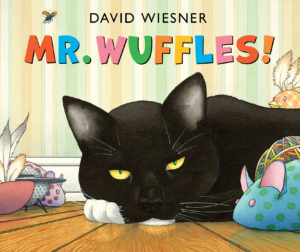 My stories grow out of visual images and visual ideas that I’ve encountered throughout my life. In particular, certain things I first encountered as a child had an enormous impact on the pictures I would create. These things got stuck in my mind and would be reinforced over the years as I came across further examples of these ideas.
My stories grow out of visual images and visual ideas that I’ve encountered throughout my life. In particular, certain things I first encountered as a child had an enormous impact on the pictures I would create. These things got stuck in my mind and would be reinforced over the years as I came across further examples of these ideas.
There are some recurring motifs in my books: things flying that don’t really fly, changes in scale, alternate realities, and time. I can trace all of these preoccupations back to specific influences from my childhood.
My book MR. WUFFLES, for example, brings together a number of these ideas: scale change, flying saucers, and invented languages.
I loved science fiction movies as a kid. Mostly I saw old movies from the fifties and sixties. My favorites were what I call the Atomically Mutated Giant Bug Movies.
There were movies about giant spiders, giant crabs, giant praying mantises, and most unterrifyingly of all, giant bunny rabbits. This phenomenon worked the opposite way too: In The Incredible Shrinking Man, an Atomically Mutated Man shrinks to the size of a bug. Trying to climb onto his couch becomes like scaling a mountain.
This stuff is wonderful visual fantasy, based solely on changing the size of ordinary objects. Instead of characters physically moving into another reality, their own everyday world becomes new through a simple change of scale.
It was the idea of a meeting between two radically different sized beings that triggered the story that became MR. WUFFLES.
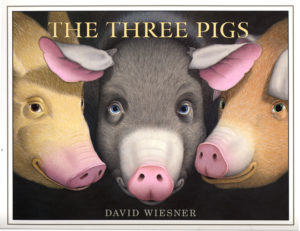 One of the other things I wanted to explore in this story was having each group of characters speak in visually different languages – that the reader of the book would not be able to read, except by reading the context of the pictures.
One of the other things I wanted to explore in this story was having each group of characters speak in visually different languages – that the reader of the book would not be able to read, except by reading the context of the pictures.
In my early teens, I visited the Philadelphia Museum of Art where I saw a sculpture by Marcel Duchamp called, “The Large Glass.” It contained many flat mechanical and organic shapes arranged and wedged between panes of glass. There was a legend that told the meaning of each object in the assemblage. It was meant to read as a kind of narrative – a visual language.
I thought that was the coolest thing I had ever seen. Artists can make up languages! All those years later, I consulted with a linguist from Swarthmore College to create three different visual languages for aliens, insects, and a cat.
These were just some of the things I was thinking about when I began to work on what would eventually become MR. WUFFLES. The hard part, of course, is to craft a good story out of those ideas. But my books grow out of those kinds of explorations.
Booking Biz: Did you always want to write books for children, or was there another career you wished for as a child?
David: I can’t remember a time when I wasn’t making pictures, lots of pictures. I never saw real artists growing up other than in history books. I didn’t really have any concept of how someone became an artist.
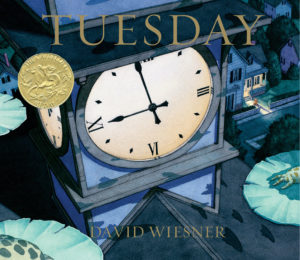 Fortunately, my parents knew to be looking into art schools when I was in high school and it was clear to everyone that art was the path I should follow. The guidance counselor was of no use. Fortunately, again, my art teacher brought someone who had graduated my high school into my ninth grade art class. This guy was now attending the Rhode Island School of Design and he showed all these projects he was working on. Art schools? Where you study art? I was ready to go right then and there. The future now opened up as I became aware of a road I hadn’t even known existed.
Fortunately, my parents knew to be looking into art schools when I was in high school and it was clear to everyone that art was the path I should follow. The guidance counselor was of no use. Fortunately, again, my art teacher brought someone who had graduated my high school into my ninth grade art class. This guy was now attending the Rhode Island School of Design and he showed all these projects he was working on. Art schools? Where you study art? I was ready to go right then and there. The future now opened up as I became aware of a road I hadn’t even known existed.
That’s a long introduction, but it was while I was a student at RISD that I really became aware of the world of picture books.
I had become more and more drawn to narrative art. Telling stories was what I began to do more of. Besides the paintings I was creating, I was making comic books and eight millimeter movies while in high school. When I got RISD, I continued to focus on narrative and sequential art.
I didn’t really know a lot of the classics of the picture books world. As I saw more of the range of stories and art that were being done then (the late seventies), I began to feel like this was a place for the things I was thinking might fit.
And then at the end of my senior year, Trina Schart Hyman came to speak about being a children’s book illustrator. She stayed a second day to look at student portfolios. I was on my way out of the Illustration Building when one of my teachers said, “Aren’t you going talk to Trina?” I hadn’t planned on it. I was considering children’s books, but for some now mysterious reason I was also considering things like science fiction and fantasy book jackets and editorial magazine illustration. Thankfully, I did show her my work.
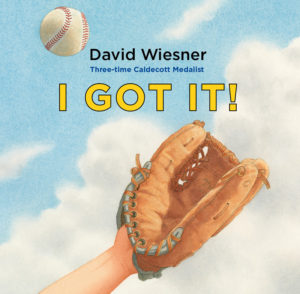 At the time, Trina was also the art director for Cricket Magazine. We had a great talk, and as we finished looking at my portfolio, she said, “How would you like to do a cover for Cricket?” I believe my reaction was something like “Huh?” I thought this must have been some kind of a cruel art joke. But she wasn’t kidding, and I did the cover, and I never thought about editorial or science fiction illustration again. This was a risky and generous offer on Trina’s part, and one that was so exciting and challenging, that it pointed me down the path to picture books without any wasteful detours.
At the time, Trina was also the art director for Cricket Magazine. We had a great talk, and as we finished looking at my portfolio, she said, “How would you like to do a cover for Cricket?” I believe my reaction was something like “Huh?” I thought this must have been some kind of a cruel art joke. But she wasn’t kidding, and I did the cover, and I never thought about editorial or science fiction illustration again. This was a risky and generous offer on Trina’s part, and one that was so exciting and challenging, that it pointed me down the path to picture books without any wasteful detours.
Booking Biz: If you ruled the world, what would it look like?
David: Wow, there are a lot of ways to go with this. But I’ll continue the line of thought from my previous answer.
I’m shocked when I visit schools that have no arts classes of any kind. Or libraries. How can these be non-essential?
The arts are not about making pretty pictures. They offer the mind a chance to break out of its regimented thinking and discover modes of self-expression. These are things that are important to all students, not just those kids like me who were “good at art,” although giving those kids an outlet is essential too.
So, arts for all kids. Books, too.
Booking Biz: We couldn’t agree more!
Read more about David Wiesner and his books on his speaker page.
